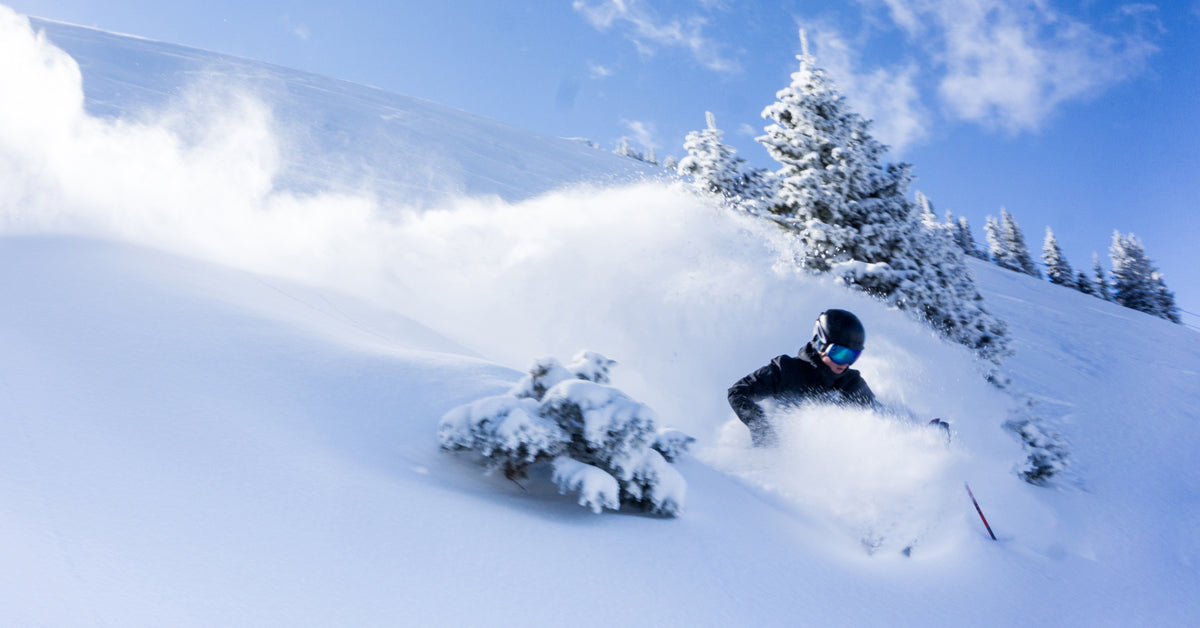
Get Ready for Ski Season
There’s no better time than now to tune your body for optimal ski conditioning. Here are some guidelines and workouts to get you ready for a long and healthy winter season.
The most important thing when it comes to working out is making the time. Carving out five to seven hours per week should be a priority. An hour to an hour and a half of focused workouts a day will do wonders for your overall fitness and health – and leave plenty of time to accomplish all the other things life demands of you.
Exercise

It's not just about leg strength.
Skiing is a complex sport, whether you are ripping around the resort or lapping the backcountry, and it makes complex demands on your body. For this reason, I suggest breaking ski prep training programs into a few categories:
Endurance is the base. Without it, your ski days are shorter, your muscles are more tired and your probability for injury increases. Get in at least one 90-plus minute run, hike, or bike ride in every week, and more if you have time.
Strength and power sound similar, yet they fall into different categories. I define strength as pure force production (i.e. pushing your truck across the parking lot) while power is the rate of force production (i.e. sprinting, jumping etc.). Strength and power are both critical to good skiing and staying fit and healthy during ski season.
Injury-proofing and balance are the final piece, and an important one at that. Time in the gym should focus on compound movements that require multiple muscle groups to coordinate. This replicates real-world movements and improves balance.
Proper Diet

We all know what a proper diet looks like, even if we sneak in a few fries now and then.
We know you know, but consider exercise and proper diet a package deal. Look at what and how much you eat each day. Do you eat because you need calories and are actually hungry, or is it because you are bored at work? Balance your meals with good proteins, fats and carbohydrates. Remember that easy diet substitutions can help you shed a few pounds over time. And, while we are on the subject, alcohol contains a ton of “garbage” calories and slows your metabolism. If you aren’t burning more calories each day to offset it, alcohol can be easy calories to cut.
Schedule
What should your workout look like and what is the best ski-fit training program? In short, it’s the program you will commit to doing. A typical training week might look something like this:
Monday – Upper Body
Tuesday – Lower Body
Wednesday – Cardio, core, and injury proofing
Thursday – Upper Body
Friday – Lower Body
Saturday – Endurance
Sunday – Rest/Recovery: 2 to 3-hour easy walk, hike, swim or bike
Let’s dive into it. Here are some of the best gym workouts for skiers.
Deadlifts & Box Jumps
Deadlift
No single exercise does more for my overall ski fitness than the deadlift. This, combined with explosive box jumps, is the ideal strength/power hybrid exercise to help strengthen the legs, lower back, and core. It will also help develop the explosive strength necessary for that critical jump turn in a crux. A proper deadlift is critical for protecting your back.
Start with your shins against the bar. Feet should be shoulder-width apart. Hands should grip the bar just wide enough to avoid interfering with your knees. Lean back onto your heels with your head and eyes forward, tighten the core and drive upward through your heels. Pinch your shoulder blades together at the top of the lift. Set it down in reverse order – it is important to either drop the bar, or move through the negative with power and strength – going halfway between will likely result in injury.
Box Jumps
For the explosive box jump, first find an appropriately sized box – high enough to make the jump difficult, but not to the point of failure. For the jump to aid in power, it will require a two second pause with your quads parallel to the floor. The key with explosive box jumps is to drive the hips up from a dead stop, powering your feet above the box and landing with straight legs. Using your arms to assist is helpful in developing the full body power we want.
Kettlebell (KB) Swing & the Romanian Deadlift (RDL)
Kettlebell (KB) Swing
As skiers, we often focus on our quads and neglect our posterior chain (low back, glutes and hamstrings). Weakness there can mean imbalance and puts a great deal of stress on our knees. The combination can lead to injury. The Kettlebell (KB) Swing and the Romanian Deadlift (RDL) are ideal for improving posterior strength.
The KB Swing is the perfect exercise for undoing all the damage we do sitting in front of a computer. It helps straighten out the back while strengthening the lower back and hips, building a stable core that can handle all the stresses skiing places on the body. When done properly the KB Swing also has a cardiovascular benefit due to the breathing involved. Big tip: Don’t go straight for the biggest KB in the gym. Start small. This movement is more about doing it correctly than how much weight you can pick up.
Women should start with 8kg to 16kg KBs. Men should start in the 16 to 25kg range). Plan three sets of ten, two to three times per week, for a max benefit. To perform the KB swing:
1) Get set: stand with feet shoulder-width apart, toes pointed out, and knees slightly bent; look straight ahead.
2) Hold the Kettlebell between your legs using a two-handed, overhand grip.
3) Begin the swing. Keeping your lower back arched, flex your hips until the kettlebell is between and behind your legs; squeeze your glutes to extend your hips and swing the weight up. The KB doesn’t need to come any higher than chest-high.
4) Let the weight swing back between your legs as you bend your hips and slightly bend your knees. If the bell hits you in the butt, you’re doing it right.
5) Extend your hips and knees to reverse the momentum as you immediately begin the next rep.
Romanian Deadlift (RDL)
The Romanian deadlift is a way to give your hamstrings some love with very low injury risk. For men, a 24kg KB is a good start and for women, 20kg is appropriate. To perform the RDL:
1) Begin by placing the KB between your feet, back by the heels.
2) Bend the knees slightly and drive your butt backward – like you’re about to jump forward. Look straight ahead and grab the KB with both hands while maintaining a neutral spine.
3) Squeeze your glutes and stand up, allowing your shoulder blades to be pulled down.
4) Reverse the motion by pushing your hips backward. Getting the KB to the ground isn’t important – feeling it in your hamstrings is.
A great way to start is by standing 12-18 inches out from a wall (facing away from the wall). Drive your butt backwards until it touches – you should almost feel like you’re about to fall backwards. The drive backwards will force your body to hinge forward. I use these as supplemental exercises after sprinting and jumping days, 3 to 5 sets of 10.
Single-Leg (SL) Box Squat & Reverse Goblet Lunge
Single-leg exercises help with several things: correcting strength/size left-right imbalances, working around injuries, and improving balance. These exercises provide a strong carryover to sport due to the similarity in movement. My single-leg exercises of choice include single-leg box squats and reverse goblet lunges.
Dylan Freed, former pro skier says, “We do not attempt to re-enact the exact physical demands of sport while training in the gym; it’s therefore absolutely necessary to incorporate many single leg and typically ‘unstable or balance-focused’ movements into every training session. This mostly contrived environment of the gym is the proper time and space to place heavy emphasis on body control and awareness. Stable and strong on one leg is balanced and prepared on two.” I recommend a variety of combinations, but generally work each leg with similar sets and weights.
Single-Leg (SL) Box Squat
For the SL Box Squat, start on a low box to get comfortable with the movement — a staircase can work here. Assume a single-leg stance with one foot off the edge. Squat by flexing the knee while keeping the heel on the box (or stair-step), while minimizing the movement at the ankle. As you sink, raise your arms to shoulder height as a counterbalance. Squat until the thigh is parallel to the floor. Then, power back up using only the leg you are balancing on. Work your way up to a 20-inch box and do three to five sets of eight to ten reps for each leg.
Reverse Goblet Lunge

Don't have a kettlebell? An elastic band would work, too.
The Reverse Goblet Lunge is another great exercise for the glutes and hamstrings, while still loading up the quads. It is also less stressful on the knees. Hold your KB with both hands just below your chin, with head up and a “proud chest.” This helps with breathing and core stabilization through the movement. Starting with your right foot, step backward as far as you can, and then lower your leg until your right knee touches the ground. Be careful to keep your front shin vertical and your weight on your heel. Then rise up and repeat with the left leg. Three sets of ten reps will get your attention here.
There are countless ways to get in shape for ski season, and each athlete requires some personalization based on prior injury and specific goals. These guidelines and workouts are a starting place. I recommend joining a local gym or CrossFit that can help with specific training and programming, as well as ensure proper movements to avoid injury. Avoid big box gyms unless it’s your only option and look for a trainer who will invest in you. Remember that getting hurt in the gym only means less time in the snow.
--
Article by Jake Hutchinson
Jake has spent more than 25 years working as an avalanche professional. He is currently a lead instructor for the American Avalanche Institute, an avalanche dog handler and trainer and an avalanche safety consultant to the resort and rescue communities. Off the snow, Hutchinson is a Certified Instructor and former Head of Instructor and Seminar Development for Gym Jones in Salt Lake City. He is currently involved in private personal training with an emphasis on high level functional fitness for mountain and military athletes.


